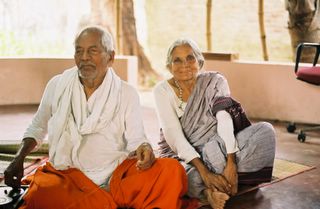Poompuhar
Last Saturday, I went with the Valivalam hostel girls on their excursion to Poompuhar. Poompuhar was the ancient capital and great seaport of the Chola kings in the first millennium AD, and is the setting for the great Tamil epics Cilapattikaram and Manimekalai about which I have written previously. The city is now at the bottom of the sea, destroyed in some great wave thousand years ago.
I met up with the girls in Kilvelur and climbed into one of the two rented buses, one of which had a banner reading “Valivalam Girls’ Hostel Excursion to Poompuhar” on the front. The bus was crowded, but only crowded enough that a few of the littlest girls had to sit on others’ laps. We set off on the three-hour journey to Poompuhar. I was sitting across from a 12th-standard girl of my own age named Hindumani, who remembered my sister from when we visited in ’98, and who had the best English of anyone on the bus.
The trip was a lot of fun. I don’t often spend much time with kids (I’ve never had a babysitting job in my life), but the excursion gave me a lot of amusement and Tamil practice. Associating with children is a great way to learn a language! I was wedged into the edge of a three-person bench holding five people, and I kept sliding off the side. The driver was playing Tamil pop music at full volume. A little girl named Sathya of about nine years, in a green dress much too big for her, got up from where she had been sitting on the floor at my feet and started to dance, falling over frequently and being pushed back upright as the bus turned or stopped. Hindumani took Sathya’s scarf and tied it around her waist, holding the ends so that she wouldn’t fall over so much. We passed Tiruvarur, driving through the countryside, where rice seedlings were being transplanted, their unbelievable greenness startling the eye. I don’t think you have seen the color green until you have seen a young paddy field.
We reached Poompuhar around ten-thirty, and ate a mid-morning meal of curd rice. The children were obviously enjoying practicing their English on me, although they kept saying, right in the middle of the conversation, that they knew no English (or they would point at other people, who were trying to talk, and say “No English!”).
After the meal, the girls were made to stand in a double file with the youngest in front to go through the museum. The women leading the group kept trying to make me stand in the line, or hold their hand, which I didn’t appreciate. Anyone who has known me for a while will know how much I hate being herded. I’d make a much better goat than a cow.
There wasn’t really anything in the museum besides some depictions of scenes from the Cilapattikaram done by a not-very-talented artist. I much prefer my own mental pictures of Madhavi and Kannaki and Kovalan, the three main characters of the epic. Outside in the garden, there was a huge cloud of ladybugs swarming over the flower bushes. Above, there was an even larger cloud of green dragonflies. Hindumani succeeded in catching one by the tail, something that I have never been able to do in all my summers of trying, but Indian dragonflies seem to be more numerous but slower than American ones.
After this we went down to the beach which was sandy, but had large rocks across it. There weren’t many buildings right on the beach, no ghosts of the tsunami. We took off our sandals and went to play in the waves, jumping and splashing. Boats floated in the distance. I thought about the last time I had been to the ocean, and realized it was at the cremation of one of the bodies we found in Akkarapattai, not too far down the coast, but so far mentally from this scene of laughing children. The girls bought ice cream cones from a roadside vendor.
We got back on the bus, but our return journey took seven hours instead of three, because we seemed to stop at every village and temple along the way. First we stopped at one temple to rest and eat, where I sang to the girls and played “ring-around-the-rosy” with some of the littlest children, eight- or nine-years-old. Then we stopped at another temple to make an offering. Then the driver had to make a phone call. Then a girl got off at her own village because she was spending the weekend at her parents’ house, and the women who went to take her to the house took an hour to return. Finally I got back to Kilvelur, where the other LAFTI people, who had been in the other bus, had been waiting for over an hour, and it was already dark. We took a bus back to Kuthur, which was thankfully not very crowded, though I still had to stand. I noticed how segregated the bus was by gender. The women, myself included, all sat or stood towards the front, while the men were behind us. I was very glad to get back and eat dinner.
Ah, Indian transportation.
Aliyah
(David’s note: There is an excellent English translation of The Cilapattikaram (“The Tale of the Anklet” by the poet and translator R. Parthasarathy, a professor at Skidmore College. (Columbia University Press, 1992). It is much worth going out of your way to find: it is to Tamil civilization what the Iliad and Odyssey are to ancient Greek, only it is still part of living tradition.)


0 Comments:
Post a Comment
<< Home